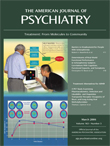Dr. Cipriani and Colleagues Reply
To the Editor:
We thank Dr. Connemann for his interest in our work. As we stated in our article, we routinely contact the original authors to obtain data on deaths and suicides and to confirm reported figures. We appreciate that this might make it difficult for readers who check the primary publications to understand where all of the figures come from. The suicide figures from the Multicentre Study of Long Term Treatment of Affective Psychoses (MAP) trials were initially derived from the article primarily reporting suicidal events by Thies-Flechtner et al. (1) and subsequently checked with the MAP investigators, who kindly went to great lengths to answer our questions. The apparent discrepancies from the other MAP publications (both Greil et al. citations from the letter by Dr. Connemann and reference 2) depend on the method of analysis. We chose to use a full intent-to-treat approach in which all randomly assigned patients were included in the analyses (3).
As we also emphasized, the small total number of events in our analysis meant that even small variations in counting events or unpublished findings could have had a large effect on the pooled estimates. Therefore, we did several secondary analyses to investigate how sensitive the pooled estimates were to the results of individual trials. In fact, if we used only the results from the maintenance phase data from the MAP trials, the pooled odds ratio for suicide is 0.14 (95% confidence interval [CI]=0.02–0.82), suicide plus deliberate self-harm is 0.14 (95% CI=0.05–0.37), and overall mortality is 0.44 (95% CI=0.19–1.02). Exclusion of the MAP trials altogether gives a suicide odds ratio of 0.14 (95% CI=0.02–1.02), a suicide plus deliberate self-harm odds ratio of 0.14 (95% CI=0.03–0.72), and all-cause mortality odds ratio of 0.47 (95% CI=0.20–1.10).
Therefore, such was the homogeneity of the findings between trials that, notwithstanding the weight accorded to them in the overall analysis, exclusion of the MAP studies—or variations in the way that events are counted—did not materially affect the overall pooled estimate. The conclusion remains the same: the available randomized evidence suggests that lithium exerts a consistent—and substantial—antisuicidal effect on patients with mood disorders.
1. Thies-Flechtner K, Muller-Oerlinghausen B, Seibert W, Walther A, Greil W: Effect of prophylactic treatment on suicide risk in patients with major affective disorders: data from a randomized prospective trial. Pharmacopsychiatry 1996; 29:103–107Crossref, Medline, Google Scholar
2. Greil W, Ludwig-Mayerhofer W, Erazo N, Engel RR, Czernik A, Giedke H, Muller-Oerlinghausen B, Osterheider M, Rudolf GA, Sauer H, Tegeler J, Wetterling T: Comparative efficacy of lithium and amitriptyline in the maintenance treatment of recurrent unipolar depression: a randomised study. J Affect Disord 1996; 40:179–190Crossref, Medline, Google Scholar
3. Sackett DL, Gent M: Controversy in counting and attributing events in clinical trials. N Engl J Med 1979; 301:1410–1412Crossref, Medline, Google Scholar



